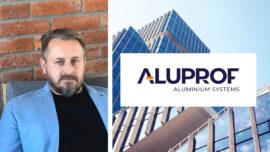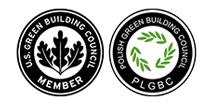
On April 15th, 2021, visio architects and consultants team provided introductory sustainable training to professionals from Aluprof located in several countries. On the top of multicriteria approach to green buildings, the training related to how green buildings can help reduce carbon emissions and how companies like Aluprof can play their part in the process.
About the Company
visio architects and consultants have been helping various companies in an attempt to achieve LEED (and other) certifications for their architectural projects for over 12 years. The company is the first Polish member of the USGBC (since 2004) and is a platinum founding member of the PLGBC. It offers various services and has trained various professionals from within Poland as well as from other countries in the field of green building and certifications like LEED, BREEAM, DGNB, HQE, and WELL. Having worked on various multi-regional projects, visio now offers trainings either directly or via the PLGBC.
Training About LEED and LCA
In this training, Rafal Schurma, who is a LEED Fellow the founder of visio as well as of PLGBC with 16 years of teaching experience, took the lead in an attempt to familiarize the attendees with what it means for a building to be truly green. The training talked about how green buildings can reduce CO2 emissions, water use, energy use, and solid waste. A strong focus was placed on the fact that green buildings do not cost more in the long run, as opposed to popular belief.
He also gave the attendees a very detailed look into LEED and other certifications. Attendees were taught about the requirements that are to be met across the many different categories. Also discussed were the various ways in which buildings could strive for and achieve the ‘credits’ that apply to them in the certifications’ particular categories.
A part of this training was dedicated to the importance of Life Cycle Assessment or LCA for short. Here, the LCA Analyst for visio, Saram Maqbool, talked to the attendees about what LCA really is and how it can help a building significantly cut down its energy use and carbon footprint. Special attention was given to how material choices in any construction project can alter the amount of energy that is utilized. The professionals from Aluprof were also made aware of their role in this process, as manufacturer-provided transparent EPDs are crucial for the success of processes like LCA.
The Importance of LEED Certification
LEED stands for Leadership in Energy and Environment Design. This is a certification program launched by the USGBC through which buildings can be certified as LEED Certified, LEED Silver, LEED Gold, and LEED Platinum, depending on how many credits they can achieve.
But why should buildings strive to be certified by LEED in the first place? Here are some benefits to keep in mind:
- A LEED-certified facility can significantly boost the company’s image in the public eye as an environmentally conscious institution. Not only that but the designer or developer can also boost their own image by working on such projects. By having a LEED-certified building in their portfolio, they can well be on their way to becoming specialists and leaders in the industry.
- LEED certification has been found to help homes sell quicker. Buildings with this certification are also more likely to retain their value over time.
- And of course, if your building gets this certification, it means that it will be good for the environment while also using less energy which leads to lesser operational costs over time.
- LEED certification is currently present in 188 (out of 193) countries is the most widely-known certification in the category of green building.
The Importance of LCA
LCA, or Life Cycle Assessment, is a process through which a building’s material embodied energy is calculated over its lifetime. A building has both operational and built-in energies. In LCA, we focus on calculating the built-in energy that is supplemental to the operational energy. This process helps designers and building owners to find out what impact their buildings will have over the years and how they can reduce it. Performing LCA is important for buildings looking for LEED certification as it can grant crucial credits.
Here are some ways in which an LCA can help during the design process:
- It can give you a clear picture of what materials are impacting the energy requirements the most. This, in turn, gives you the chance to replace materials that have very high energy demand with those that are more ‘green’.
- This process gives you the opportunity to compare and contrast the various material choices available on the market based on how sustainable they are. The greener your material choice, the lesser the amount of CO2 that is emitted into the atmosphere over the lifetime of your building.
LCA analysis is supplementary to the comprehensive LEED approach, and they should go hand in hand in the sense that both processes are designed to help building owners be more mindful of the products and systems they choose for their buildings – material and performance-wise at the same time. Our world needs our buildings to continuously use lesser energy, and striving for a LEED and other certifications gives builders and designers enough benefits to start thinking seriously about true green transformation.
This post is written by Saram Maqbool – Architect and Life-Cycle Assessment Analyst at visio.


